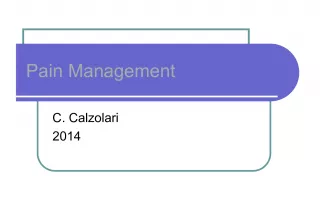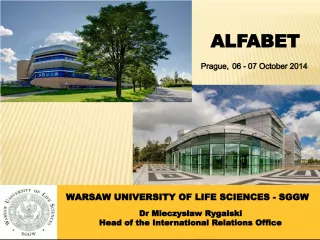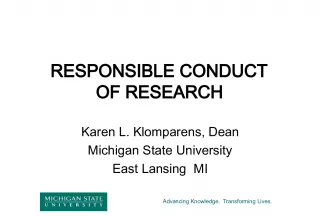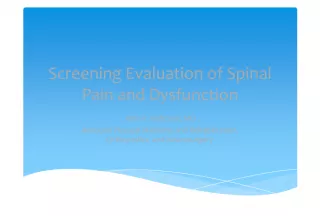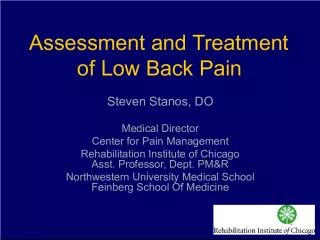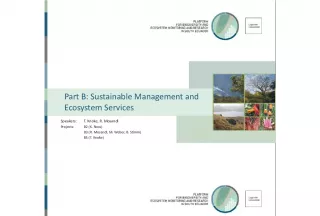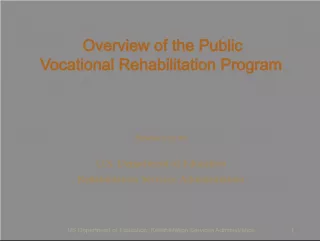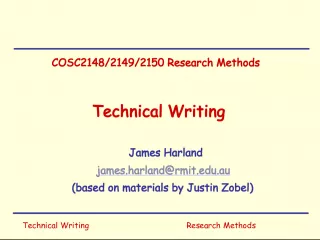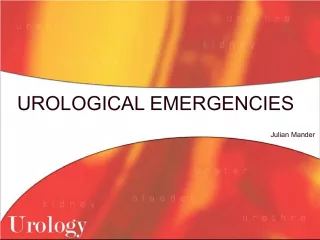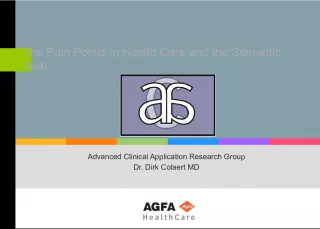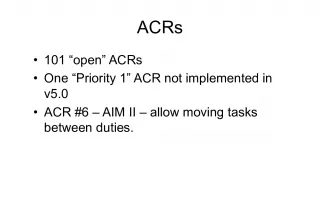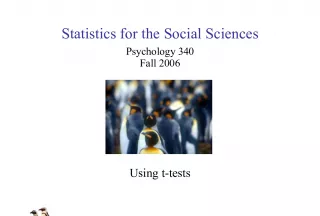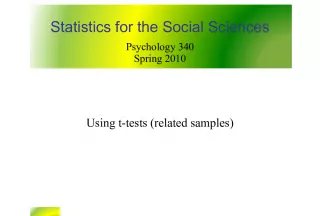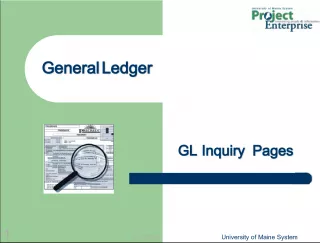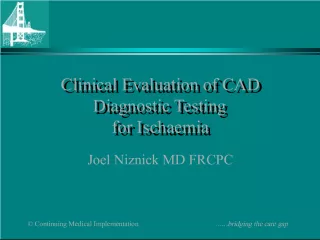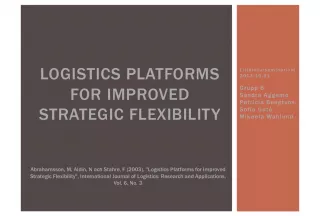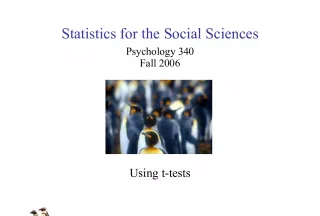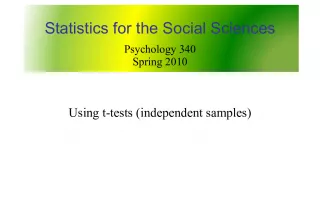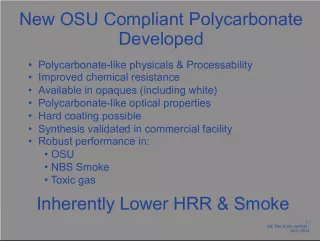Advancing Rehabilitation Sciences Research for Improved Functionality and Pain Management
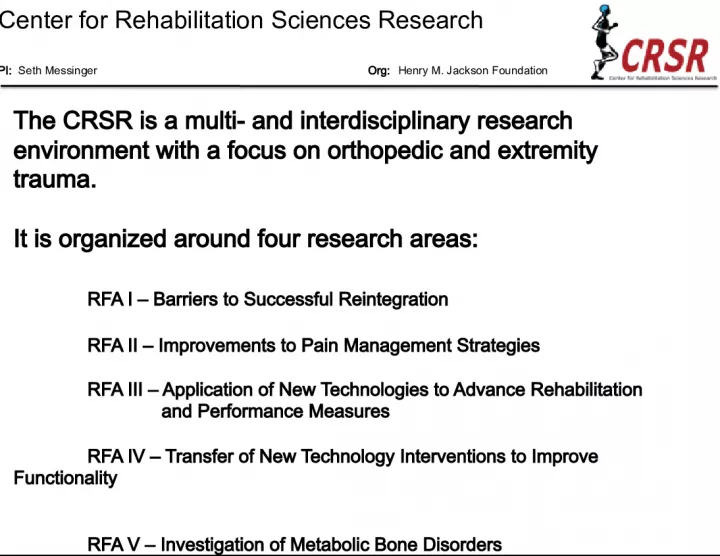

The Center for Rehabilitation Sciences Research (CRSR) is an interdisciplinary research institute that focuses on orthopedic and extremity trauma. It is divided into five research areas, including barriers to successful reintegration, improvements in pain management strategies, application of new technologies to advance rehabilitation and performance measures, transfer of new technology interventions to improve functionality, and investigation of metabolic bone disorders.
- Uploaded on | 1 Views
-
 haland
haland
About Advancing Rehabilitation Sciences Research for Improved Functionality and Pain Management
PowerPoint presentation about 'Advancing Rehabilitation Sciences Research for Improved Functionality and Pain Management'. This presentation describes the topic on The Center for Rehabilitation Sciences Research (CRSR) is an interdisciplinary research institute that focuses on orthopedic and extremity trauma. It is divided into five research areas, including barriers to successful reintegration, improvements in pain management strategies, application of new technologies to advance rehabilitation and performance measures, transfer of new technology interventions to improve functionality, and investigation of metabolic bone disorders.. The key topics included in this slideshow are rehabilitation sciences, orthopedic trauma, extremity trauma, pain management, new technology interventions,. Download this presentation absolutely free.
Presentation Transcript
1. Center for Rehabilitation Sciences Research PI: Seth Messinger Org: Henry M. Jackson Foundation The CRSR is a multi- and interdisciplinary research environment with a focus on orthopedic and extremity trauma. It is organized around four research areas: RFA I Barriers to Successful Reintegration RFA II Improvements to Pain Management Strategies RFA III Application of New Technologies to Advance Rehabilitation and Performance Measures RFA IV Transfer of New Technology Interventions to Improve Functionality RFA V Investigation of Metabolic Bone Disorders
2. Research Focus Area I PI: Seth Messinger Org: Henry M. Jackson Foundation Research Focus Area I: Barriers to Social Reintegration Background: Research Focus Area I is a snapshot of life after limb-loss for current and former Military Advanced Training Center (MATC) patients. Goal : To investigate the process and experience of social reintegration after the wounded warrior leaves the rehabilitation program. Importance : The approach offers one of the only holistic attempts to understand and interpret the contours of post injury life for wounded warriors with extremity trauma. Team : Seth Messinger, PhD Director of Qualitative Research Robert Humphreys, BA Research Assistant
3. Research Focus Area I: Barriers to Social Reintegration There are potential external and internal barriers to reintegration within community life Examples of external barriers: Difficulty Accessing Benefits or Continuing Care Former patients might not receive prompt appointments for health care; They have difficulties in identifying private practitioners; They experience lengthy waits for services They find the community to be physically inaccessible. They have problems with school or work administrations They perceive themselves to be unwelcome. Research Focus Area I PI: Seth Messinger Org: Henry M. Jackson Foundation
4. Research Focus Area I: Barriers to Social Reintegration Examples of internal barriers: Social stigma Former patients feel unwelcome because of physical and / or psychological injury Continuing neuro - psychological injuries Symptoms make social engagement too difficult Social isolation Injuries may make interacting with others intimidating or anxiety producing scarring, bladder bowel issues, difficulty ambulating, reliance on wheelchairs, etc are all potentially contributing factors. Social isolation can exist on its own or as a consequence of other internal barriers. Research Focus Area I PI: Seth Messinger Org: Henry M. Jackson Foundation
5. Research Focus Area I: Research Approach Our Approach is to focus on the social and cultural factors that contribute to these experiences and barriers. Increasing attention among health services researchers to questions of the social psychological cultural worlds. Gallagher, P. 2004: The psychosocial world of the person with limb-loss is a strong predictor of prosthetic utilization or abandonment Napier, D. 2014: Culture is one of the single most important variables in a good clinical outcome. Research Focus Area I PI: Seth Messinger Org: Henry M. Jackson Foundation
6. Research Focus Area I: Anthropology What is Anthropology and why is it useful for studies of this kind? Among veterans life after injury remains largely uncharted. Studies about social reintegration of Vietnam veterans are only being launched in part to address concerns about OIF / OEF veterans. Anthropology is useful for mapping out under-explored social terrain. Especially areas that are not yet amenable to quantitative social research. Significant attention to the meaning, ideals and experiences of study participants. Initially definitions of key terms should be those of the participants. Surveys cannot capture this. Research Focus Area I PI: Seth Messinger Org: Henry M. Jackson Foundation
7. Research Focus Area I: Methods Anthropological Approaches and Methods Developing a Natural History Periods of observations during clinic routines; Periods of observation outside of the clinic, off base, in the community (when possible); Develop a catalog of key concepts, terms, values, ideals generated from observations and conversations; One hour interviews around key themes, etc., to expand, revise, and develop key concepts. Research Focus Area I PI: Seth Messinger Org: Henry M. Jackson Foundation
8. Research Focus Area I: Projects Three Ongoing CRSR Projects 1. Interpreting and Promoting Adherence among Outpatients in the MATC This study investigates the role that resilience and autonomy have in shaping good outcomes in the rehabilitation program context. 2. Social Reintegration of Service-Members with Orthopedic Injuries This study investigates the social reintegration experience of wounded warriors who have had extremity amputations and have been treated in the Armed Forces Amputee Patient Care Program (APCP). 3. Neuropsychiatric Co-morbidities and Reintegration This study investigates the role that mild traumatic brain (mTBI) injury plays in social reintegration of wounded warriors who have had extremity amputations and have been treated in the APCP. Research Focus Area I PI: Seth Messinger Org: Henry M. Jackson Foundation
9. Research Focus Area I: Recruitment Totals Study 1: Outpatients : Goal: n=20 patients and n=15 clinicians To Date: n=17 patients and n=10 clinicians Study 2: Extremity Amputation : Goal: n=20 patients To Date: n=18 patients Study 3: Amputation with mTBI : Goal: n=20 patients To Date: n=17 patients Research Focus Area I PI: Seth Messinger Org: Henry M. Jackson Foundation
10. Research Focus Area I: Results to Date from CRSR Study 1 (Current Outpatients) Current Research Results: Definition of what constitutes a good outcome from rehabilitation; Early introduction of prosthetics is a strong motivator for success; Good rapport between patient and treatment team is critical; Communication between clinical services is a continuing problem; Social reintegration efforts should begin early in treatment and be targeted as widely as possible (work, school, family, community); Unanimous support of the APCP / MATC model of care. Research Focus Area I PI: Seth Messinger Org: Henry M. Jackson Foundation
11. Current Research Results Study 1: Role of Resiliency: (Messinger n.d. under review) Resiliency is understood to be an important attribute leading to success in the face of both internal and external obstacles and challenges Resiliency is both an internal attribute and an external set of resources; External sources are drawn from clinicians, families, and other patients; The MATC can deliver resiliency to patients and thus create a strong foundation of success for leaving the program. Research Focus Area I PI: Seth Messinger Org: Henry M. Jackson Foundation
12. Research Focus Area I: Results to Date from CRSR Studies 2 & 3 (Former Patients) Overview of Positive Outcomes: No distinguishing differences between participants in studies 2 and 3. We find no distinction between patients with or without mTBI. PTSD and mTBI do not have a marked impact on lives of participants; All patients have taken or acknowledge opportunities for higher ed; 32 of 35 are employed or left for higher ed; Unanimous support of the APCP / MATC model of care. Research Focus Area I PI: Seth Messinger Org: Henry M. Jackson Foundation
13. Community Participation Sport: (Messinger 2012a, Messinger 2012b) While sports participation has tailed off for at least 30 of 35 patients participation in sports during rehab is credited with contributing to a sense of success. Succeeding at physical challenges provides a stock of resiliency to draw upon when faced with new challenges from community ambulation to dating to raising children. Education Opportunities (Messinger et al 2013) All former patients have acknowledged higher-ed opportunities. Those who have not opted to go back to school are a) college graduates; b) returned to duty; c) still searching. Research Focus Area I PI: Seth Messinger Org: Henry M. Jackson Foundation
14. Community Participation Higher Ed (contd): Most have taken advantage of exploring bachelor degree programs Retired officers (and other grads) have gone on to graduate work in business and engineering Searchers investigating fit between M.O.S and potential career. Work: (Messinger et al 2013) 32 of 35 are or have been fully employed (of those not working all but 3 are in school). Four remain in military service Research Focus Area I PI: Seth Messinger Org: Henry M. Jackson Foundation
15. Community Participation Work contd: Six work as GS or as contractors for a range of government departments Several others work in admin, or are entrepreneurs in a variety of enterprises. Family: (Messinger et al 2013) Just under 30 are married or in long-term relationships. Many are parents Relationships are a mix of pre and post injury Research Focus Area I PI: Seth Messinger Org: Henry M. Jackson Foundation
16. Community Participation Values: (Messinger 2013b) Former patients bring their military experience to bear on challenges of community life Symptoms that are associated with PTSD become sources of resiliency Hypervigilance is associated with protecting family and community Guardedness is associated with situational awareness in warding off crime and other safety issues. Research Focus Area I PI: Seth Messinger Org: Henry M. Jackson Foundation
17. Research Focus Area I: Results to Date from CRSR Studies 2 & 3 (Former Patients) Overview of Causes for Concern: One suicide attempt This attempt was treated as a substance abuse disorder / patient was encouraged to retire from the military The former patient feels that the underlying grief and loss of his amputation was not addressed. There was a completed suicide by a former patient (not enrolled in the study in 2012) This is important in the context of the high rate of active duty and veteran suicide. Research Focus Area I PI: Seth Messinger Org: Henry M. Jackson Foundation
18. Research Focus Area I: Results to Date from CRSR Studies 2 & 3 (Former Patients) Causes for Concern: Two cases of long-term substance abuse unrelated to pain management. In both cases drugs were cocaine and heroin In one case drug use was attributed as suicide gesture Heavy (> 5 drinks per day) drinking reported by 25% of participants. Research Focus Area I PI: Seth Messinger Org: Henry M. Jackson Foundation
19. Research Focus Area I: Results to Date from CRSR Studies 2 & 3 (Former Patients) Causes for Concern: 25% divorced or divorcing Causes Pre-existing marital problems Married too young Married without a lot of experience as couple; New problems generated by the injury and its aftermath. Caregiver burnout Conflicts over jobs, parenting, household chores Research Focus Area I PI: Seth Messinger Org: Henry M. Jackson Foundation
20. Research Focus Area I: Results to Date from CRSR Studies 2 & 3 (Former Patients) Causes for Concern: (Messinger et al 2013) Social Isolation Social networks limited to service period friends and veterans; Disinterest in forging relationships with new people. Negative power of identity has potential consequences on longer-term outcomes. Research Focus Area I PI: Seth Messinger Org: Henry M. Jackson Foundation
21. Research Focus Area I: Manuscripts in Preparation (2014) Messinger, Seth. Identity, Care and the State: Wounded Warriors and Negotiating a Good Clinical Outcome. Planned submission to Medical Anthropology Quarterly Messinger, Seth. Pathways from Injury: Community Reintegration and Wounded Warriors after Physical Rehabilitation. planned submission to Ethos: Journal of the Society of Psychological Anthropology Lewis, Allen, Messinger, Seth, Humphreys, Bob. Culture and Reintegration chapter for proposed book by Cooper, Rory and Pasquina, Paul (eds). Promoting Successful Reintegration: A Practical Handbook Humphreys, Robert and Messinger, Seth. Prosthesis as Surrogate for Masculinity. Planned submission to Disability and Rehabilitation Humphreys, Robert and Messinger, Seth. Videogaming as a Tool for Social Reintegration. Planned submission to Physical Medicine and Rehabilitation Clinics of North America Research Focus Area I PI: Seth Messinger Org: Henry M. Jackson Foundation
22. Research Focus Area I: Future Projects SUMMARY OF NEWLY FUNDED STUDIES Life After Limb-Loss This study offers the opportunity for continued monitoring of patients with traumatic limb loss as they begin to live their lives in the community. Interviews will be conducted at one year intervals to investigate and interpret changes in work, family, social and other aspects of life in communities. Life After Limb-Salvage This will be one of the first attempts to study this category of combat injured veterans. Key question is the role that physical functioning may play in social reintegration into community life. Another key question is the role clinic organization may play in future social reintegration. Limb- loss patients have received outpatient care in highly structured clinical environments among patients with similar injuries. For limb-salvage patients this has not always been the case. This may also influence social reintegration into community life. Continual Monitoring of Study Populations I These projects will be a continuation of Life after Limb-Loss and Life After Limb-Salvage. The goal is to transform this project into a long-term longitudinal observation of OIF / OEF veterans with extremity injuries. PI: Seth Messinger Org: Henry M. Jackson Foundation
23. Anthropology & Human Centered Design Anthropologic contributions to community integration research Focus on former patients Attention to detailed accounts of life after injury Understanding the symbolic modes of community integration Focus on long-term relationships An important step in informed hypothesis development Can complement and add depth to quantitative research Research Focus Area I PI: Seth Messinger Org: Henry M. Jackson Foundation
24. Anthropology & Human Centered Design Translating Anthropological Research Results into Practices HCD is a process by which we can turn qualitatively oriented results into actionable service and device design. Emerged from User Centered Design based on the idea that the end users concerns should be considered at every stage of design Origin was concerned with the interface of humans with technology Critiques that have been made of this process are that humans do better adapting to technology than trying to adapt technology for humans Prime example is the car humans have successfully adapted to the act of driving using the same configuration of controls for over a century HCD principles can lead to over-complex design Research Focus Area I PI: Seth Messinger Org: Henry M. Jackson Foundation
25. Human Centered Design Using HCD to address problems uncovered in our research HCD can potentially address the following problems Technology abandonment is a critical challenge High rate of abandonment of upper extremity and above knee prosthetics Abandonment of prosthetics can lead to problems accessing services, work and community Uncertainty about challenges of community integration is a barrier to successful integration A holistic and cohesive policy overview for the wide range of service providers would help to overcome barriers to integration Research Focus Area I PI: Seth Messinger Org: Henry M. Jackson Foundation
26. Human Centered Design Using HCD to address problems uncovered in our research Methods of HCD Most Health Care Programs are designed on an ad-hoc basis To date there have been limited opportunities to include users in the planning process We are at a transition point as care for wounded warriors shifts from MTFs to the community Care is also fragmenting among MTFs, VAMCs, Private Providers Now is an opportunity for a HCD set of practices to influence standards of care Research Focus Area I PI: Seth Messinger Org: Henry M. Jackson Foundation
27. Human Centered Design Using HCD to address problems uncovered in our research Methods of HCD contd HCD is already present in health care settings though it is limited to: Non punitive settings to address errors; Intervening in the management of records Users of the system should be brought into designing structures of care Standard practices, based on former patients experiences, should set guidelines for future care Furthermore experience of former patients can be used to intervene in care of current and future patients Research Focus Area I PI: Seth Messinger Org: Henry M. Jackson Foundation
